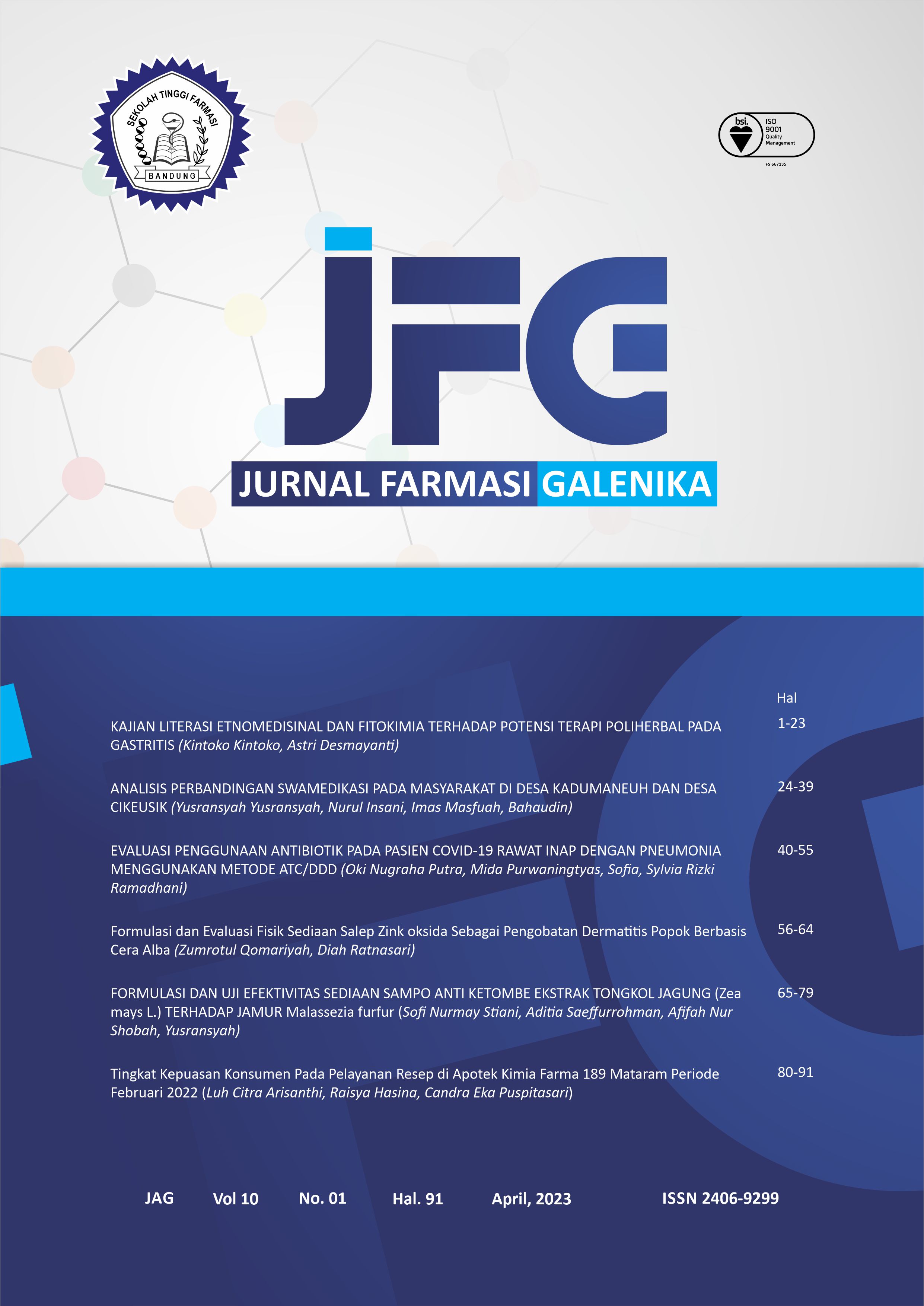Formulasi Dan Uji Efektivitas Sediaan Sampo Anti Ketombe Ekstrak Tongkol Jagung (Zea Mays L.) Terhadap Jamur Malassezia Furfur
DOI:
https://doi.org/10.70410/jfg.v10i1.289Keywords:
sampo, antifungi, tongkol jagung, Malassezia furfurAbstract
Ekstrak tongkol jagung dinilai berkhasiat atau bermanfaat sebagi zat aktif anti ketombe yang disebabkan oleh jamur Malassezia furfur yang merupakan flora normal pada kulit kepala. Sampo ekstrak tongkol jagung merupakan sediaan kosmetik yang dibuat dari bahan dasar ekstrak tongkol jagung dan penambahan bahan lain yang tidak dapat menimbulkan reaksi iritasi pada kulit kepala, penelitian ini bertujuan untuk mengetahui aktifitas sediaan sampo tongkol jagung terhadap jamur Malassezia furfur dan memformulasikan tongkol jagung menjadi sediaan sampo anti ketombe yang memenuhi peryaratan uji evaluasi fisik sediaan. Penelitian ini bersifat eksperimental dengan beberapa pengujian yaitu, skrining fitokimia, evaluasi organoleptis, pengukuran pH, uji tinggi busa, viskositas, dan uji homogenitas. Hasil penelitian ini menunjukan formula sampo antiketombe ekstrak tongkol jagung menunjukan bahwa telah memenuhi evaluasi sifat fisik serta terbuktu dapat menghambat pertumbuhan jamur Malassezia furfur dengan nilai rata-rata zona hambat terbesar yaitu 7mm yang termasuk ketegori sedang 6-8mm.
Downloads
References
Anna K Jager, S.H.F. (2014) “Correlation between Plant Secondary Metabolites and Their Antifungal Mechanisms–A Review,†Medicinal & Aromatic Plants, 03(02).
Dhanani, T. et al. (2017) “Effect of extraction methods on yield, phytochemical constituents and antioxidant activity of Withania somnifera,†Arabian Journal of Chemistry, 10, hal. S1193–S1199.
Hadriyati, A. et al. (2020) “Analisis Asam Retinoat Pada Krim Pemutih Malam Yang Beredar Di Klinik Kecantikan Kota Jambi Pada Kecamatan Jelutung Retinoid Acid Analysis of Night Bleaching Cream Circulating Beautiful Clinic Beauty of Jambi City in Jelutung District,†1, hal. 1–12.
Ikalinus, R., Widyastuti, S. dan Eka Setiasih, N. (2015) “Skrining Fitokimia Ekstrak Etanol Kulit Batang Kelor (Moringa Oleifera),†Indonesia Medicus Veterinus, 4(1), hal. 77.
Lestari, D., Wardoyo, E.R.P. dan Linda, R. (2021) “Aktivitas Ekstrak Metanol Rimpang Lengkuas Merah (Alpinia purpurata K. Schum) Terhadap Pertumbuhan Jamur Malassezia furfur,†Protobiont, 10(3), hal. 74–80.
Lukman, A. dan Wahyuni, A. (2017) “Formulasi Sampo Perasan Jeruk Purut (Citrus hystrix D.C) dan Uji Aktivitas Anti Ketombe Terhadap Jamur Penyebab Ketombe (Pityrosporum ovale) Secara In Vitro,†Penelitian Farmasi Indonesia, 6 No 1, hal. 35–41.
Lumempouw, L.I. et al. (2012) “Potensi Antioksidan Dari Ekstrak Etanol Tongkol Jagung (Zea mays L.),†Chemistry Progress, 5(1), hal. 49–56.
Mikhania, C.E., Falahi, A. dan Oktavionita, J. (2022) “Pengaruh Variasi Konsentrasi Carbopol 934 Sebagai Pengental Terhadap Sifat Fisik Sediaan Sampo Infusa Daun Pandan Wangi (Pandanus amaryllifolius Roxb.),†5(1), hal. 24–30.
Misery, L. et al. (2013) “Epidemiology of dandruff, scalp pruritus and associated symptoms,†Acta Dermato-Venereologica, 93(1), hal. 80–81.
Putri, R.K. dan Habib, I. (2007) “Daya Antifungi Ekstrak Etanol Daun Beluntas against Malassezia Sp . in vitro,†7(1), hal. 7–17.
RodrÃguez-Miranda, J. et al. (2022) “Phytochemical screening, polyphenols content and antioxidant activity of by-products of two corn variety,†Emirates Journal of Food and Agriculture, 35(10), hal. 806–814.
Saxena, M. et al. (2013) “Phytochemistry of Medicinal Plants,†Journal of Pharmacognosy and Phytochemistry, 1(6).
Shaikh, J.R. dan Patil, M. (2020) “Qualitative tests for preliminary phytochemical screening: An overview,†International Journal of Chemical Studies, 8(2), hal. 603–608.
Suket, N., Srisook, E. dan Hrimpeng, K. (2014) “Antimicrobial Activity of the Anthocyanins Isolated from Purple Field Corn (Zea mays L.) Cob against Candida spp,†IOSR Journal of Pharmacy and Biological Sciences, 9(4), hal. 40–44.
Susanty dan Bachmid, F. (2016) “Comparison Of Maceration And Reflux Extraction Methods To Phenolic Levels Of Corn Cob Extract (Zea mays L.),†Jurnal Konversi, 5(2), hal. 87.
Tarigan, N. (2009) “Pemanfaatan Kulit Jagung dalam Pembuatan Barang Kerajinan untuk Menigkatkan Ekonomi Rumah Tangga.,†JURNAL Pengabdian Kepada Masyarakat, Vol.15 No.
Wilkinson, J.B. dan Moore, R.J. (1982) Harry’s Cosmeticology. 7th ed. London: Geogre Godwin.
Williams, S.. dan Schmitt, W.. (2012) Chemistry and Technology of the Cosmetics and Toiletries Industry. Netherland: Springer Netherlands.
Zhou, R. et al. (2022) “Formulation and evaluation of a herbal shampoo using flavonoid glycosides from Dicerocaryum senecioides,†East African Journal of Science, 3(Special), hal. 2.
Downloads
Published
How to Cite
Issue
Section
Citation Check
License
Authors who publish in Jurnal Farmasi Galenika agree to the following terms:
This license enables reusers to distribute, remix, adapt, and build upon the material in any medium or format, so long as attribution is given to the creator. The license allows for commercial use. CC BY includes the following elements:
BY: credit must be given to the creator.
You are free to:
- Share — copy and redistribute the material in any medium or format for any purpose, even commercially.
- Adapt — remix, transform, and build upon the material for any purpose, even commercially.
- The licensor cannot revoke these freedoms as long as you follow the license terms.
Under the following terms:
- Attribution — You must give appropriate credit , provide a link to the license, and indicate if changes were made . You may do so in any reasonable manner, but not in any way that suggests the licensor endorses you or your use.
- No additional restrictions — You may not apply legal terms or technological measures that legally restrict others from doing anything the license permits.
Notices:
You do not have to comply with the license for elements of the material in the public domain or where your use is permitted by an applicable exception or limitation .
No warranties are given. The license may not give you all of the permissions necessary for your intended use. For example, other rights such as publicity, privacy, or moral rights may limit how you use the material.










